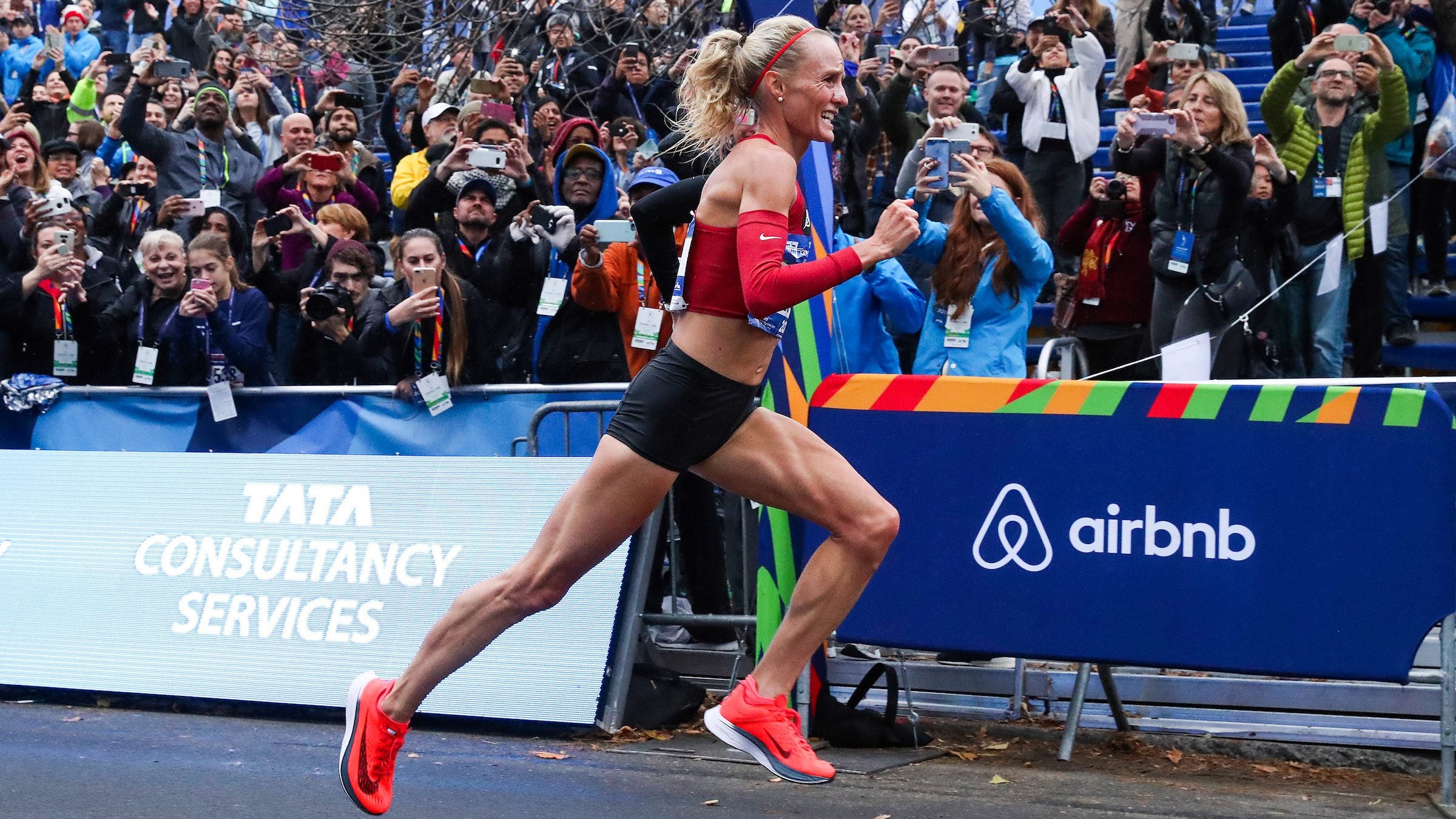Should You Lean Forward When You Run?

NEW YORK, NY - NOVEMBER 5: Women's professional division runner Shalane Flanagan runs towards the finish line in Central Park to win the 2017 TCS New York City Marathon on November 05, 2017 in New York City. (Photo by PhotoRun/New York Road Runners via Getty Images)
If you watch elite runners compete in any major marathon, road, or track race, you’ll find that nearly all of them have a strong forward lean in their technique. Their graceful strides propel them forward, with a diagonal line from heel to head as their bodies lean ever so slightly forward.
Many coaches and articles repeat the classic advice to have a “forward lean” in your form while running. But should runners actively try to lean forward while we’re running to emulate elite athletes and follow this advice?
The answer is decidedly no.
That’s because a forward lean is actually an advanced concept that’s the result of good running form and a high level of strength. It’s not an element of good form that we should consciously try to cue and work on, but rather enjoy as a byproduct of sound training done consistently over time.
Let’s discover why a forward lean is so difficult and how to structure training that makes it easier to incorporate into your own technique.
Why Shouldn’t Runners Try to Lean Forward?
Even though a slight forward lean is desirable in your running form, it’s not a great idea to try to lean forward the next time you go running, for a variety of reasons.
First, form changes should always be taken seriously, and attempted only if you’re experiencing problems in your running. Retraining the gait can cause different problems, so any changes to your form should be done gradually, and ideally in conjunction with, and as the result of, improved mechanics from working on mobility and specific strengths.
RELATED: Training Predictors Of Long-Distance Running Performance
In addition, attempting to lean forward almost always invites problems. When we try to lean forward, we inevitably lean from the waist and put our bodies in an uneconomical position that increases our risk of injury. Leaning from the waist puts additional strain on the back and hamstrings, and can cause lower back pain. Not to mention, it will certainly make running feel harder.
Instead, your forward lean must come from the ankles. Imagine that your body is a straight line; it can lean, but at no point should it be bent along that line. This is a particularly helpful form cue that helps you maintain a tall, athletic posture while running.
To lean properly from the ankles, however, we must build the skill of speed (yes, running fast is definitely a skill!) during training. Much like a low resting heart rate is not something you try to have but instead is a result of training your cardiovascular system, an effective forward lean has to be earned through training strength and skill, not by thinking about it.

Leaning Forward is Partly a Function of Speed
Another critical reason why runners shouldn’t try to arbitrarily incorporate a forward lean into their technique is because it’s partly dependent on how fast you’re running.
RELATED: Why Running Slow Is Good For You
If you head out the door for a very easy recovery run, you’ll have far less forward lean than if you were sprinting close to your maximum speed. It doesn’t help your form to lean forward very much during an easy effort; in fact, you’ll either fall or you’ll bend at the waste and it will require muscular effort to hold your body out of balance in front of your hips and legs.
On the other side of this spectrum, imagine a 100-meter sprinter accelerating out of the blocks on the track. This athlete is rapidly increasing her pace at a time when she’s leaning so far forward that she’d fall on her face if she were to stop running.
These examples illustrate that a forward lean is a type of “dynamic balance” in the words of elite coach Bobby McGee. Your body is balanced out in front of your center of mass because of your forward motion catches you with each step; the speed is mandatory to prevent falling on your face. When you decelerate and stop you need to straighten up to a static, vertical balance.

A Forward Lean Requires Strength
Yet another reason why it’s ill-advised to practice a forward lean is because you might not be ready for it! While leaning from the ankles puts the body in an ergonomic, economical position that’s conducive to fast running, the forward lean demands quite a bit of strength in your core, hips and feet.
Not only must runners be strong enough to maintain high speeds but they must be strong enough to maintain good form during periods of stress — like the high fatigue during challenging workouts and races. Anybody who’s watched marathoners in the final miles of the race — or been there themselves — understands that fatigue can wreak havoc on running technique. A high level of strength makes a forward lean possible and more sustainable when you’re tired.

Build Your Forward Lean
If a forward lean is a byproduct of sound training and not something we should consciously work to cue, the question becomes, “What training activities help us develop a forward lean in our running form?”
First, we should get comfortable running fast regularly. We can accomplish this in several ways:
- Run strides and/or hill sprints 1-3 times per week
- Run 1-2 weekly speed workouts at a variety of paces (based on your ability and goal, of course)
- Race a variety of distances regularly
By running fast consistently, you’ll become more comfortable with the mechanics and neuromuscular recruitment required. Speed is a skill and demands regular practice.
But running fast also helps build strength. When you run faster, you must impart more force into the ground, requiring stronger muscular contractions. Over time, fast runners become quite strong simply by running fast frequently.
We can also supplement these strength gains by lifting weights in the gym. A weightlifting program focusing on strength and power (rather than on endurance, cardiorespiratory fitness, or hypertrophy) will help runners in myriad ways.
Lifting heavy weights improves strength, power, and injury resilience. These skills ensure you have the strength to run with a forward lean and also stay healthy to train consistently.
Weight lifting also helps us build more economical form by improving intra- and inter-muscular coordination. Muscles will fire and work together more efficiently, leading to better running form overall.
Tall and Balanced
Ultimately, runners should not attempt to incorporate a forward lean into their technique. Focus on running tall and balanced, and create the environment in which a forward lean can develop naturally and at the right pace.
A focus on regular fast running with consistent strength work is the best path to developing an athletic, economical stride — with a slight, full-body, dynamically-balanced forward lean.
RELATED: 5 Principles to Improve Your Marathon Pacing
From PodiumRunner